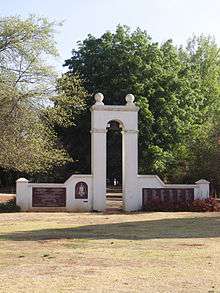Huguenot Monument
 | |
| Location | Franschhoek, South Africa |
|---|---|
| Completion date | 1945 |
| Opening date | 17 April 1948 |
.jpg)
The Huguenot Monument in Franschhoek, Western Cape, South Africa, is dedicated to the cultural influences that Huguenots have brought to the Cape Colony (and ultimately the whole of South Africa) after their immigration during the 17th and 18th centuries.
The monument was designed by J.C. Jongens, completed in 1945 and inaugurated by Dr. A.J. van der Merwe on 17 April 1948.
The three high arches symbolizes the Holy Trinity, the Father, Son and Holy Spirit. On top of the arches is the sun of righteousness and above that, the cross of their Christian faith.
The central female figure, created by Coert Steynberg, personifies religious freedom with a bible in her one hand and broken chain in the other. She is casting off her cloak of oppression and her position on top of the globe shows her spiritual freedom. The fleur-de-lis on her robe represents a noble spirit and character.
The southern tip of the globe shows the symbols of their religion (the Bible), art and culture (the harp), the agriculture and viticulture (the sheaf of corn and grape vine) and industry (spinning wheel).
The water pond, reflecting the colonnade behind it, expresses the undisturbed tranquility of mind and spiritual peace the Huguenots experienced after much conflict and strife.
The Huguenot Memorial Museum neighbouring the monument elaborates on the history of the French Huguenots who settled in the Cape, and especially in the Franschhoek Valley. On exhibition are the various tools they used to make wine, clothes they wore and the culture and desire for a better life that they brought with them.
Also on the site are wine cellars joined by a colonnade, which bears the words Post Tenebras Lux (lit. "after darkness [comes] light"). It was the motto of the Protestants during the Reformation, and is also inscribed on the Reformation Wall in Geneva, Switzerland.
Other Huguenot monuments and memorials in South Africa

- In the Johannesburg Botanical Garden there is a memorial commemorating the 300th anniversary of the arrival of the Huguenots in South Africa.
- In the Joubert Square of Wellington, Western Cape, there is the Huguenot Fountain.
- On Queen Victoria Street, Cape Town, stands the Huguenot Memorial Building which was erected by the Huguenot Memorial Society. The mortal remains of President Kruger lay here before being taken to rest in the Netherlands.
See also
External links
| Wikimedia Commons has media related to Huguenot Monument. |
| Wikimedia Commons has media related to Saasveld House. |
